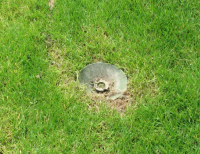Guest Post By: Rachael Jones
When it comes to lawn care, we all know that it is best to cut your grass a little long to prevent rapid regrowth and that it is generally better to water in the morning than in the evening. But what are some of the tips and tricks that professionals use to keep lawns in great shape? You may never have heard about some of these tricks before, but you will be sure to notice the difference once you put them into place.
Lawn Mower Maintenance
Too many people think that if the mower works, it works. The truth is that a lawn mower is just like your car; it only works well if you take care of it. To make sure that your lawn mower is doing the job as well as it should, you should give it at least bi-yearly maintenance. At the absolute least, you need to change the oil, clean the air filter, balance and sharpen the blades and have it inspected. Many experts recommend changing the spark plugs on a regular basis as well to ensure your mower doesn’t break down mid-mow.
Test Your Soil
There are plenty of great lawn fertilizers out there, but if you don’t know which one to get, you are running a high chance of actually poisoning your lawn rather than aiding its healthy growth. The solution is to have a soil test done. A soil test is often available for free or for a very minimal fee from your local agricultural university, and you can find out what the soil for your lawn actually needs. Depending on where you are, you may need nitrogen, potassium, phosphorus or even lime or sulfur to promote healthy lawn growth.
Plant White Clover
If you want something a little off the beaten path, you’ll find that more and more experts are recommending that you plant some white clover. Despite years of being thought of as a weed, it’s actually a fantastic plant for an ecologically healthy lawn. Skip the grass, and plant clover instead, which is basically evergreen, tolerant of drought, and resistant to most insects and disease. It does not need to be mowed often, and it stores atmospheric nitrogen, allowing it to fertilize the rest of your garden as well.
Better Grass Seed Practices
Are you thinking about how to make sure that those bare spots get re-seeded well? You’ll discover that it is a good idea to think about how you are taking care of your grass seed. In the weeks before you spread your seed on the spots in question, keep them on a dark shelf or even in the refrigerator. This causes the seeds to think that they are going through the cycle of the year, making them more likely to sprout once the weather gets better. Spread the seeds across the bare spot, cover it with a scattering of compost and then keep the area consistently damp for the next for the next few weeks or until the grass comes up.
Consider Your Expectations
A healthy lawn is not necessarily a lawn that is completely smooth, amazingly even and perfectly green, and nor do the opposite conditions mean your lawn is in disarray. If you are a single person with a job, a family and a social life, your lawn is not going to look like the fairways on the PGA Tour, nor will it resemble the lawns of mansions. Places that have a full-time staff and access to a lot of tools are going to have nicer turf than you are. Accept that, and make sure that the lawn you have meets your standards, not those of other people.
Rachael Jones is a blogger for DIYMother, where women aren’t afraid to use power tools in a dress.

